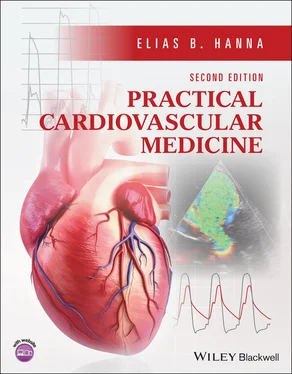21 Chapter 21Figure 21.1 Algorithm for the diagnosis of pulmonary embolism*Most hospita...Figure 21.2 (a)Massive bilateral PEs in the proximal right and left pulmona...
22 Chapter 22Figure 22.1 Aggressive early therapy of septic shock (the first 3 hours).Ea...Figure 22.2 General approach to cardiogenic shock. Right heart catheterizati...Figure 22.3 Relationship between stroke volume and CVP. A true Frank–Starlin...
23 Chapter 23Figure 23.1 Effect of ACE-I/ARB on the renal flow and renal function.Angiot...Figure 23.2 Autoregulation curve. Autoregulation of microvascular (mainly ar...
24 Chapter 25Figure 25.1 Diagnostic approach to distinguish between precapillary PH (pulm...Figure 25.2 Treatment algorithm for patients with PAH. Connective tissue dis...Figure 25.3
25 Chapter 26Figure 26.1 Management of syncope. Also, consider severe hypovolemia, bleedi...Figure 26.2 Rhythm monitoring in a 63-year-old patient with episodic prolong...Figure 26.3 Episode of complete AV block on loop recorder, with 3 non-conduc...
26 Chapter 27Figure 27.1 Quick rule-in and rule-out algorithm using hs-troponin (in ng/L,...
27 Chapter 28Figure 28.1 Aortic or mitral endocarditis can extend into the valvular annul...Figure 28.2 The AV node, and particularly the His bundle coming off the AV n...Figure 28.3 (a)Duration of antibiotic therapy in patients with device infec...
28 Chapter 30Figure 30.2 (a) Normal posteroanterior chest X-ray.Note that the RV does no...Figure 30.3 Chest X-ray in HF.(1) Cephalization and vessel extension to the...Figure 30.4 Various morphologies of cardiomegaly.LA enlargement is characte...Figure 30.5 The same X-ray is shown (a) without and (b) with annotations. Pr...Figure 30.6 Lateral chest X-ray.Note that the LA shadow is surrounded by th...
29 Chapter 31Figure 31.1 P–QRS–T complex. P wave represents the atrial depolarization and...Figure 31.2 Arrows show the spread of the electrical depolarization. Ventric...Figure 31.3 Illustration of how the electrical depolarization spreads in the...Figure 31.4 Illustration of how electrical depolarization spreads in the hea...Figure 31.5 Illustration of how electrical depolarization spreads in the hea...Figure 31.6 Frontal view of the precordial leads. Normally, R wave progressi...Figure 31.7 Regular QRS rhythm with a P wave before each QRS complex: sinus ...Figure 31.8 Irregular tachycardia with no repetition of any R–R pattern. No ...Figure 31.9 Narrow complex tachycardia with a pseudo-r’ in lead V 1that repr...Figure 31.10 Wide complex tachycardia: VT vs. SVT with bundle branch block. ...Figure 31.11 Bradycardia with regular P waves and regular QRS complexes, unr...Figure 31.12 Severe bradycardia with regular P waves and regular QRS complex...Figure 31.13 Irregularity with a pattern. Wide premature complexes with ST–T...Figure 31.14 Atrial flutter with variable conduction (3:1, 4:1). The sawtoot...Figure 31.15 There are two groups of beats followed by pauses ( asterisks ), w...Figure 31.16 Start by looking at leads I and aVF. If QRS is negative in lead...Figure 31.17 Poor R-wave progression probably secondary to LVH with a sudden...Figure 31.18 Normal and abnormal RA and LA deflections. Atrial depolarizatio...Figure 31.19 Right atrial enlargement and left atrial enlargement. Reproduce...Figure 31.20 LVH with secondary ST–T depression in the left lateral leads, d...Figure 31.21 QRS is (–) in lead I and (+) in lead aVF, implying a right-axis...Figure 31.22 In RBBB, the vector of depolarization spreads from the left sep...Figure 31.23 RBBB. rSR’ is seen in V 1, notched R wave is seen in V 2, and rsR...Figure 31.24 Sinus tachycardia with RBBB (rSR’ in V 1–V 2, wide and slurred S ...Figure 31.25 LBBB. In the lateral leads, there may be an “M-shaped” R wave (...Figure 31.26 LBBB (slurred R wave in the left leads: V 5–V 6and I–aVL) ( arrow ...Figure 31.27 WPW with short PR segment and slurred R wave. The upslope of R ...Figure 31.28 In LAFB, the vector of depolarization spreads from the posterio...Figure 31.29 LAFB + RBBB. QRS is wide > 120 ms with rSR’ in V1 and a wide...Figure 31.30 RBBB + LPFB. Since QRS is wide > 120 ms, look in V 1and in V 6t...Figure 31.31 (a)Electrical alternans. Note the alternation between two main...Figure 31.32 Wide Q wave (QS or QR) may be normally seen in lead III of a ho...Figure 31.33 Examples of an abnormal Q wave. (a)ECG shows minimal ST elevat...Figure 31.34 Inferior Q waves and anterolateral QS waves (QS waves are wide ...Figure 31.35 QS pattern is seen in leads V 1–V 2, small R wave is seen in lead...Figure 31.36 In expiration, Q wave is wide and deep in leads III and aVF ( ar ...Figure 31.37 ST-segment and T-wave morphologies in cases of (a)secondary ab...Figure 31.38 Example of left ventricular hypertrophy with typical secondary ...Figure 31.39 Electrocardiogram of a patient with angina at rest and elevated...Figure 31.40 Examples of Wellens-type T-wave abnormalities. (a)Wellens-type...Figure 31.41 Non-Wellens biphasic T waves. (a)Biphasic T wave in leads V 2–VFigure 31.42 Examples of posterior infarction. (a)ST-segment depression in ...Figure 31.43 Example of subtle ST-segment elevation in two contiguous leads ...Figure 31.44 Hypokalemia and electrocardiographic abnormalities. (a)Note th...Figure 31.45 Global T-wave inversion with marked QT prolongation in a 77-yea...Figure 31.46 Examples of normal variants of repolarization. (a)Persistent j...Figure 31.47 (a)Upsloping ST-segment depression in sinus tachycardia. Durin...Figure 31.48 Various patterns of ST-segment elevation. Reproduced with permi...Figure 31.49 Diffuse ST elevation in ~ all leads and ST depression in lead a...Figure 31.50 ECG of a patient who has lung cancer. Sinus tachycardia with di...Figure 31.51 Early repolarization with ST-segment elevation in the inferior ...Figure 31.52 Early repolarization with a normal variant T-wave inversion in ...Figure 31.53 Diffuse ST elevation in most leads, with ST depression in lead ...Figure 31.54 SVT with a typical LBBB in leads I and aVL. Concordant ST eleva...Figure 31.55 LBBB with discordant ST-segment changes. However, the T wave is...Figure 31.56 LBBB with abnormal T waves. (a, b)Discordant ST elevation in VFigure 31.57 At first glance, it seems there is ST elevation in the inferior...Figure 31.58 (a)There are ST elevations in leads V 1–V 4, ST depressions in t...Figure 31.59 Atrial flutter that simulates ST-segment elevation. “F” indicat...Figure 31.60 Atrial flutter that simulates ST-segment depression. The undula...Figure 31.61 Type 1 Brugada pattern in V 1and V 2, with a downsloping ST elev...Figure 31.62 STEMI ECG variants. Right image- DeWinter complex in V1-V6. Mi ...Figure 31.63 QT is not measured using the end of the T wave. Instead, a line...Figure 31.64 Typical ST–T morphologies in hypokalemia, hypocalcemia, congeni...Figure 31.65 On the left, markedly prolonged QT with a notched T wave is see...Figure 31.66 Hypokalemia and a pattern that should not be confused with hypo...Figure 31.67 Two ECG examples of hypokalemia. (a)Prolonged QT (QT ~600 ms, ...Figure 31.68 Stages of hyperkalemia.Figure 31.69 (a)Hyperkalemia of 6.1 mEq/l. Note that T waves are not tall, ...Figure 31.70 Hypocalcemia and hypercalcemia.Figure 31.71 Digitalis effect in a patient with AF. Note the prominent U wav...Figure 31.72 Hypothermia. QRS is prolonged > 120 ms. It is not a typical LBB...Figure 31.73 Change of vector of depolarization between a normal heart and p...Figure 31.74 Poor precordial R-wave progression with a very small R wave < 1...Figure 31.75 Poor precordial R-wave progression with a monophasic Q (QS) in ...Figure 31.76 Approach to narrow complex tachycardias.Figure 31.77 Narrow complex tachycardia. A deflection is seen at the end of ...Figure 31.78 Narrow complex tachycardia, irregular. Differential diagnosis:...Figure 31.79 The rhythm is irregular. Look for P waves: P waves are present,...Figure 31.80 Regular wide complex tachycardia. SVT vs.VT? Look for P wave...Figure 31.81 Run of irregular wide complex tachycardia. The irregularity doe...Figure 31.82 Location of the AV block.Figure 31.83 Repetition of groups of beats separated by a pause. Think of se...Figure 31.84 Regular, narrow complex rhythm, rate ~55 bpm. P waves are seen ...Figure 31.85 AF with a ventricular rate that is slow and mostly regular. Thi...Figure 31.86 Regular wide complex rhythm interrupted by narrower complexes t...Figure 31.87 2:1 AV block that can be easily mistaken for sinus bradycardia,...Figure 31.88 Outside the PVCs, the rhythm seems grossly regular. Analyze the...Figure 31.89 Regular narrow complex rhythm without any P wave. This is a jun...Figure 31.90 Regular narrow complex rhythm (~50 bpm). Negative P waves are s...Figure 31.91 Sinus rhythm is interrupted by a wide complex rhythm. The wide ...Figure 31.92 Right and left arm electrodes switched. The leads’ axis changes...Figure 31.93 Right arm and right leg electrodes switched. The leads’ axis ch...Figure 31.94 Right arm and right leg electrodes switched. Note how lead II i...Figure 31.95 Subendocardial ischemia (diffuse ST depression, not localized t...Figure 31.96 Phases of STEMI.Figure 31.97 The patient presents with chest discomfort that has started 4 h...Figure 31.98 In inferior MI, the LCx current of injury looks to the left and...Figure 31.99 The rhythm initially appears to be sinus bradycardia (~55 bpm)....Figure 31.100 Frontal plane of left-axis deviation.This may be secondary to...Figure 31.101 Horizontal plane of LV hypertrophy.The vector of depolarizati...Figure 31.102 (a) Frontal plane of RV hypertrophy or RV strain such as PE.T...Figure 31.103 (b) Horizontal plane of COPD. (a) Horizontal plane of RV hyper...
Читать дальше












